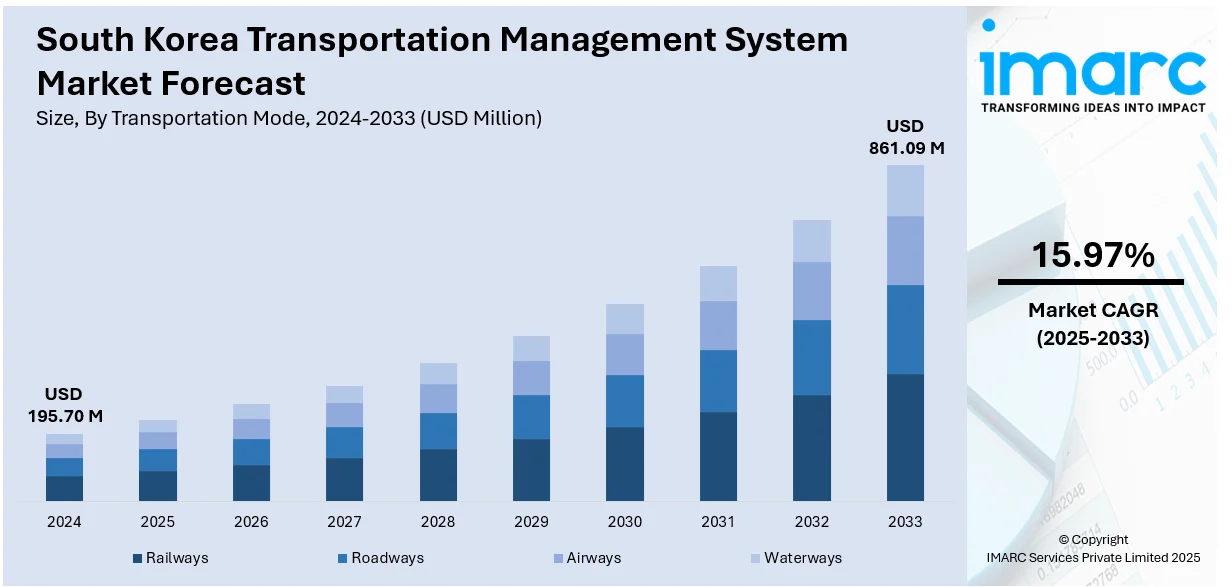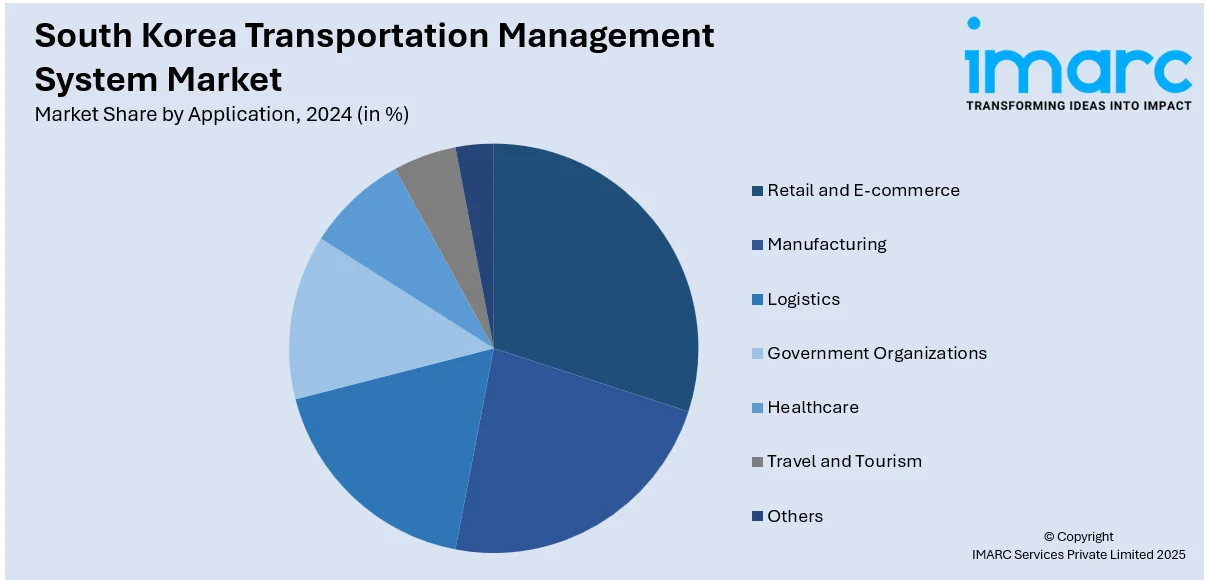
South Korea Transportation Management System Market Size, Share, Trends and Forecast by Transportation Mode, Offering, Deployment Type, Application, and Region, 2025-2033
South Korea Transportation Management System Market Overview:
The South Korea transportation management system market size reached USD 195.70 Million in 2024. Looking forward, the market is expected to reach USD 861.09 Million by 2033, exhibiting a growth rate (CAGR) of 15.97% during 2025-2033. The market is growing steadily, driven by rising demand for efficient logistics, real-time tracking, and digital fleet management. Increasing e-commerce activity, smart mobility initiatives, and adoption of AI and IoT technologies are also transforming transport operations, thus shaping the evolving landscape of the South Korea transportation management system market share.
|
Report Attribute
|
Key Statistics
|
|---|---|
|
Base Year
|
2024
|
|
Forecast Years
|
2025-2033
|
|
Historical Years
|
2019-2024
|
| Market Size in 2024 | USD 195.70 Million |
| Market Forecast in 2033 | USD 861.09 Million |
| Market Growth Rate 2025-2033 | 15.97% |
South Korea Transportation Management System Market Trends:
Rapid Growth of E-Commerce and Logistics Demand
The growth of South Korea's online commerce industry has tremendously increased the demand for effective and timely logistics systems. With the growth in online purchases, companies are increasingly being pressured to provide faster, more secure deliveries. This change has spurred the large-scale implementation of transportation management systems (TMS) that facilitate real-time tracking, route optimization, and efficient order fulfillment. As consumer demand for same-day and next-day delivery increases, TMS platforms enable the digital capabilities to manage shipments, alleviate delays, and improve transparency throughout the supply chain. Third-party logistics (3PL) providers and last-mile carriers also use TMS to expand operations, lower costs, and stay competitive within a rapidly changing digital environment.

To get more information on this market, Request Sample
Integration of Smart Technologies in Transport Infrastructure
South Korea’s strong commitment to smart infrastructure development is accelerating the adoption of transportation management systems, which is further driving the South Korea transportation management system market growth. Technologies like IoT, AI, and cloud computing are being increasingly applied to logistics operations for making them more efficient, fuel-efficient, and predictive decision-making. These technologies enable companies to track fleet performance in real time, optimize routes according to traffic conditions, and automate important supply chain functions. Smart mobility initiatives supported by governments and public-private collaborations are also creating an environment that facilitates sophisticated transport management. With the country embracing fully integrated transport systems, TMS solutions are critical in providing open communication between warehouses, trucks, and distribution centers, fueling market expansion in industries with high logistics content.
Government Support and Regulatory Push for Digitalization
The South Korean government has introduced various policies and funding programs to encourage the digital transformation of logistics and transportation. Initiatives under the “K-Smart Logistics” strategy aim to promote digital infrastructure, automation, and intelligent transport systems nationwide. These efforts include grants for system upgrades, tax incentives for technology adoption, and pilot programs in urban freight and smart mobility. Furthermore, regulatory frameworks mandating electronic documentation and data-sharing have accelerated the shift toward transportation management solutions. By creating a favorable business environment and addressing inefficiencies in traditional logistics models, government backing is helping businesses, particularly SMEs, modernize their operations through TMS. This support not only boosts domestic supply chain efficiency but also enhances the global competitiveness of South Korea’s transport sector.
South Korea Transportation Management System Market Segmentation:
IMARC Group provides an analysis of the key trends in each segment of the market, along with forecasts at the country and regional levels for 2025-2033. Our report has categorized the market based on transportation mode, offering, deployment type, and application.
Transportation Mode Insights:
- Railways
- Roadways
- Airways
- Waterways
The report has provided a detailed breakup and analysis of the market based on transportation mode. This includes railways, roadways, airways, and waterways.
Offering Insights:
- Software
- Hardware
- Services
A detailed breakup and analysis of the market based on the offering have also been provided in the report. This includes software, hardware, and services.
Deployment Type Insights:
- On-premises
- Cloud-based
A detailed breakup and analysis of the market based on the deployment type have also been provided in the report. This includes on-premises and cloud-based.
Application Insights:

- Retail and E-commerce
- Manufacturing
- Logistics
- Government Organizations
- Healthcare
- Travel and Tourism
- Others
A detailed breakup and analysis of the market based on the application have also been provided in the report. This includes retail and e-commerce, manufacturing, logistics, government organizations, healthcare, travel and tourism, and others.
Regional Insights:
- Seoul Capital Area
- Yeongnam (Southeastern Region)
- Honam (Southwestern Region)
- Hoseo (Central Region)
- Others
The report has also provided a comprehensive analysis of all the major regional markets, which include Seoul Capital Area, Yeongnam (Southeastern Region), Honam (Southwestern Region), Hoseo (Central Region), and others.
Competitive Landscape:
The market research report has also provided a comprehensive analysis of the competitive landscape. Competitive analysis such as market structure, key player positioning, top winning strategies, competitive dashboard, and company evaluation quadrant has been covered in the report. Also, detailed profiles of all major companies have been provided.
South Korea Transportation Management System Market News:
- In July 2025, Trimble and KT Corporation revealed plans to expand precise positioning capabilities across South Korea using the Trimble RTX Fast network. Through this collaboration, the two companies will jointly offer integrated services, including telecommunications, correction data, and high-precision positioning, to support automotive OEMs and Internet of Things (IoT) providers operating throughout the country.
South Korea Transportation Management System Market Report Coverage:
| Report Features | Details |
|---|---|
| Base Year of the Analysis | 2024 |
| Historical Period | 2019-2024 |
| Forecast Period | 2025-2033 |
| Units | Million USD |
| Scope of the Report |
Exploration of Historical Trends and Market Outlook, Industry Catalysts and Challenges, Segment-Wise Historical and Future Market Assessment:
|
| Transportation Modes Covered | Railways, Roadways, Airways, Waterways |
| Offerings Covered | Software, Hardware, Services |
| Deployment Types Covered | On-Premises, Cloud-based |
| Applications Covered | Retail and E-commerce, Manufacturing, Logistics, Government Organizations, Healthcare, Travel and Tourism, Others |
| Regions Covered | Seoul Capital Area, Yeongnam (Southeastern Region), Honam (Southwestern Region), Hoseo (Central Region), Others |
| Customization Scope | 10% Free Customization |
| Post-Sale Analyst Support | 10-12 Weeks |
| Delivery Format | PDF and Excel through Email (We can also provide the editable version of the report in PPT/Word format on special request) |
Key Questions Answered in This Report:
- How has the South Korea transportation management system market performed so far and how will it perform in the coming years?
- What is the breakup of the South Korea transportation management system market on the basis of transportation mode?
- What is the breakup of the South Korea transportation management system market on the basis of offering?
- What is the breakup of the South Korea transportation management system market on the basis of deployment type?
- What is the breakup of the South Korea transportation management system market on the basis of application?
- What is the breakup of the South Korea transportation management system market on the basis of region?
- What are the various stages in the value chain of the South Korea transportation management system market?
- What are the key driving factors and challenges in the South Korea transportation management system market?
- What is the structure of the South Korea transportation management system market and who are the key players?
- What is the degree of competition in the South Korea transportation management system market?
Key Benefits for Stakeholders:
- IMARC’s industry report offers a comprehensive quantitative analysis of various market segments, historical and current market trends, market forecasts, and dynamics of the South Korea transportation management system market from 2019-2033.
- The research report provides the latest information on the market drivers, challenges, and opportunities in the South Korea transportation management system market.
- Porter's five forces analysis assist stakeholders in assessing the impact of new entrants, competitive rivalry, supplier power, buyer power, and the threat of substitution. It helps stakeholders to analyze the level of competition within the South Korea transportation management system industry and its attractiveness.
- Competitive landscape allows stakeholders to understand their competitive environment and provides an insight into the current positions of key players in the market.
Need more help?
- Speak to our experienced analysts for insights on the current market scenarios.
- Include additional segments and countries to customize the report as per your requirement.
- Gain an unparalleled competitive advantage in your domain by understanding how to utilize the report and positively impacting your operations and revenue.
- For further assistance, please connect with our analysts.
 Request Customization
Request Customization
 Speak to an Analyst
Speak to an Analyst
 Request Brochure
Request Brochure
 Inquire Before Buying
Inquire Before Buying




.webp)




.webp)












